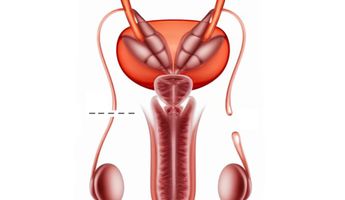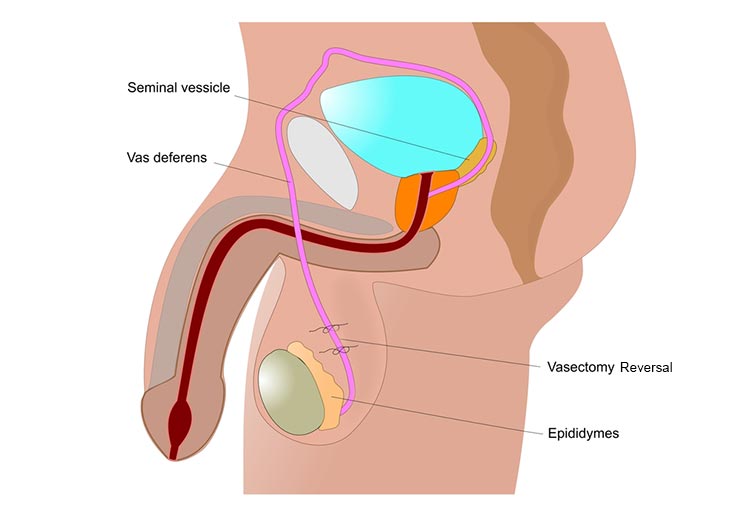Reverse Vasectomy in Iran
Search and Compare the Best Clinics and Doctors at the Lowest Prices for Reverse Vasectomy in Iran

Find the best clinics for Reverse Vasectomy in Iran
No clinics available
Czech Republic offers the best prices Worldwide
Price: $ 322

- Home
- Iran
WHY US?
At Medijump, we're making medical easy. You can search, compare, discuss, and book your medical all in one place. We open the door to the best medical providers worldwide, saving you time and energy along the way, and it's all for FREE, no hidden fees, and no price markups guaranteed. So what are you waiting for?

Free

Best Price

Widest Selection

Risk-Free
What you need to know about Reverse Vasectomy in Iran

Vasectomy is a procedure in which a male’s vas deferens tube is sealed, cut or tied to prevent the passage of sperms to the urethra. This is a permanent contraceptive technique to avoid fertilization of egg through sexual intercourse. The reversal of this method is known as reverse vasectomy. In this procedure, the ligated vas deferens tube is re-connected. It is an expensive and complicated procedure with not a great success rate. After going through this, the fertility of a male is restored and he is able to get his partner pregnant. Reverse vasectomy can be performed at any time even after a gap of 10-15 years as the sperms are continuously been produced and are viable. The pregnancy rates after this can be as low as 30% to as high as 90% depending upon the procedure used. Only 6% of all the men gone through vasectomy go for a reversal technique.
What does a Reverse Vasectomy Procedure Involve?
The surgery is performed under local, general, or regional anesthesia under the supervision of an expert urologist. A cut is given on the scrotum which opens it making the ductus deferens visible. The duct is released from the surrounding tissues and the doctor proceeds with the surgery. There are two known methods for the reversal of vasectomy:
- Vasovasostomy: In this method cut edges of the vas deferens are connected together through stitches. The surgeon sews the ends of this tube together. This reconnects the ductus deferens and the path of semen from testes to the penis is restored. This method has a lower success rate than vasoepididymostomy.
- Vasoepididymostomy: This procedure is far more complex than the one mentioned above and is performed only when the success rate seems very low with vasovasostomy. In vasoepididymostomy, severed vas deferens is connected to epididymis rather than the other end of the tube. This results in a direct transfer of sperms into the semen present in the duct. The success rate is higher in this method. Sometimes both these procedures are performed side by side. Vasovasostomy at one side and vasoepididymostomy at the other.
Only the urologist can decide which procedure should be chosen for you. However, a vasovasostomy is performed if the sperms are present in the vasal fluid. If not, vasoepididymostomy is performed. It causes the sperms to move from testes to epididymis and from epididymis to the vasal fluid.
How Long Should I Stay in Iran for a Reverse Vasectomy Procedure?
Performed in the outpatient department, reverse vasectomy is not a lengthy procedure. The surgery requires only 2 to 4 hours after which the patient is discharged on the same day from the hospital after he returns to consciousness. Still, the patient is under the influence of anesthesia so he needs someone to be with him. As far as stitches are concerned, they dissolve themselves after a few days. You should plan to stay in Iran for at least 2 to 3 days after your surgery, this will allow for the initial recovery and follow-up check-ups, etc.
What's the Recovery Time for Reverse Vasectomy Procedures in Iran?
The recovery time after a reversal vasectomy varies from person to person. It usually takes 5 days to 2 weeks for the recovery. In the first few hours, the patient is woozy due to anesthesia. There is nausea, muscle pain, swelling, fatigue, and sore throat. After the effects of anesthesia fade away the day after surgery, pain is elevated. The recovery process is completed in 2 weeks.
What sort of Aftercare is Required for Reverse Vasectomy Procedures in Iran?
The incision is stitched and covered with bandages. There is pain after surgery which varies from moderate to severe. Pain killers are prescribed to relieve the aching body. For soreness and swelling, ice packs are used. Keeping your legs above the head level might also be beneficial in reducing swelling. Ice packs are applied every half an hour for 10 minutes. Bed rest should be taken to avoid excessive movement of testes during activity. Ask the doctor when to remove the bandages. Besides all the things mentioned above, the following points should be kept in mind:
- Keep the site of surgery dry. Avoid taking a bath or swimming for at least 1-2 days after surgery.
- Avoid all such activities which cause excessive testicle movements such as jogging, running, etc. for 6 to 8 weeks after being operated upon.
- Use sports underwear for several weeks which is tight enough to keep the testes in place.
- Do not have sexual intercourse soon after undergoing surgery. Ask your surgeon when it is fine to have intercourse and to ejaculate. You should not be ejaculating for 2 to 3 weeks after surgery.
- It is advised to take rest if your job is hectic and requires physical work. However, if you do office work, you can return to it a few days after surgery.
What's the Success Rate of Reverse Vasectomy Procedures in Iran?
The success rate is variable and depends upon the individual case. Sperms come into the semen after 4 to 6 months of surgery. Your doctor regularly checks your sperm count till it returns to normal. In vasovasostomy, 6 to 12 months are required to restore the normal sperm count in the semen. While in the case of vasoepididymostomy, it might take longer. Once the sperms come back to the semen, chances to conceive can increase with the passage of time. the success rate also depends upon a number of other factors including any other illness or disease, age of female partner and the quality and quantity of sperms present in the semen.
Are there Alternatives to Reverse Vasectomy Procedures in Iran?
A reverse vasectomy might not always be successful. There are various reasons for its failure such as any other testicular diseases. In case it fails, another surgery can be performed. If it does not work, following is the alternative for reverse vasectomy:
In vitro fertilization (IVF) of the ovum: Sperms are removed directly from the testes or epididymis using a syringe or through surgery. Success rates are higher if the female partner is younger. This procedure is way more expensive than the reversal of vasectomy. Also, there are no chances of another pregnancy. While reversal is cheaper, aids in natural birth and chances of future pregnancies are also there.
Fertilization through a donated sperm is another option. You can either get sperm from a suitable donor from a sperm bank or you can use your own frozen sperms that were stored before vasectomy. Sperms are removed through a syringe and frozen under suitable conditions.
Whilst the information presented here has been accurately sourced and verified by a medical professional for its accuracy, it is still advised to consult with your doctor before pursuing a medical treatment at one of the listed medical providers
No Time?
Tell us what you're looking for and we'll reachout to the top clinics all at once
Enquire Now

Popular Procedures in Iran
Prices Start From $500

Prices Start From $2,473

Prices Start From $683

Prices Start From $275

Recommended Medical Centers in Iran for procedures similar to Reverse Vasectomy

- Interpreter services
- Translation service
- Religious facilities
- Medical records transfer
- Medical travel insurance
- Health insurance coordination
- TV in the room
- Safe in the room
- Phone in the room
- Private rooms for patients available

- Interpreter services
- Translation service
- Religious facilities
- Medical records transfer
- Medical travel insurance
- Health insurance coordination
- TV in the room
- Safe in the room
- Phone in the room
- Private rooms for patients available

- Interpreter services
- Translation service
- Religious facilities
- Medical records transfer
- Medical travel insurance
- Health insurance coordination
- TV in the room
- Safe in the room
- Phone in the room
- Private rooms for patients available
Reverse Vasectomy in and around Iran
Introduction
Iran is a country situated in Western Asia, as well as the second-largest in the Middle East. It is home to one of the oldest civilizations in the world, starting from the fourth millennium BC when the Elamite Kingdoms were formed. Iran is widely known as the jewel in Islam’s crown, filled with awe-inspiring architecture and friendly people. The country is also a popular medical tourism destination due to its efficient healthcare system and experienced specialists. The medical centers in the country keep pace with the latest medical developments and provide top-class services. International medical tourists usually come to Iran for cosmetic procedures, which are currently witnessing a vast growth. Cosmetic procedures in the country, such as rhinoplasty and hair transplant, are performed with advanced scientific techniques and are highly successful. Furthermore, the healthcare cost in the country is a lot more affordable than in many other Western countries.
Popular Cities and Regions in Iran
The capital of Iran, Tehran, is the most populous city in the country. Situated at the foot of the snow-capped Alborz mountain range, the city is filled with museums, restaurants, parks, and friendly people. The most popular landmark in this city is the Azadi Tower, which is the symbol of the city. Besides this tower, visitors can also go to the Tehran City Theater to see its amazing architecture, explore the Treasury of the National Jewels to admire the largest collection of jewels found in the world and visit the Golestan Palace, which is the oldest historic monument in Tehran. Besides Tehran, Tabriz is another popular city and it is a modern industrialized city with a very rich history and historical monuments, such as the Blue Mosque and El Goli.
Transport in Iran
The main international airport is the new Imam Khomeini International Airport in Tehran. It serves international flights to and from numerous cities around the world, including Dubai, Ankara, London, Bangkok, and Beijing. Budget airlines are operating from this airport, such as Pegasus Airlines and Air Asia. To get around Iran, domestic flights are affordable and fast. Buses and trains are also widely available with extensive networks. Taxis are best for inter-city travel.
Visas in Iran
Iran allows citizens of 16 countries to visit without a visa for up to 90 days, including Armenia, China, and Malaysia. Most citizens of other countries can obtain a visa on arrival. However, visa on arrival does not apply to citizens of 14 other countries, such as the US and the UK.
Weather in Iran
Iran experiences four seasons. Spring (March-May) and autumn (September –October) are pleasant with mild temperatures. Summer (June to August) can be scorching hot, with the temperatures soaring to 37°C. The winter can get bitterly cold as the temperatures drop to 0°C.
Additional Info
- Local Currency: The official currency is the Iranian rial (IR). 1 USD is approx. 41,921 IR.
- Money & Payments: You cannot use ATMs, credit or debit cards, or traveler's cheques in Iran. Therefore, bring all you’ll need in cash.
- Local Language: Persian is the official language in Iran. However, the country has several main languages, including Azerbaijani and Kurdish. Not many people speak English in the country.
- Local Culture and Religion: About 99% of Iran’s population is Muslims, with the Shia branch of Islam as the biggest. The two largest non-Muslim religious minorities are Christianity and Bahá'í Faith.
- Public holidays: Islamic Revolution Day, Nature Day, Eid e-Fitr, and Eid-e-Qorban are some of the most important public holidays in Iran.
Popular Searches
- Plastic Surgery in Thailand
- Dental Implants in Thailand
- Hair Transplant in Thailand
- Breast Augmentation Thailand
- Gastric Sleeve in Thailand
- Gender Reassignment Surgery in Thailand
- Laser Hair Removal in Bangkok
- Botox in Bangkok
- Dermatology in Bangkok
- Breast Augmentation in Bangkok
- Coolsculpting in Bangkok
- Veneers in Turkey
- Hair Transplant in Turkey
- Rhinoplasty in Turkey
- Stem Cell Therapy in Mexico
- Rhinoplasty in Mexico
- Liposuction in Mexico
- Coolsculpting in Tijuana
- Rhinoplasty in Korea
- Scar Removal in Korea
- Gastric Sleeve in Turkey
- Bone Marrow Transplant in India
- Invisalign in Malaysia
- Plastic Surgery in the Dominican Republic
- Tummy Tuck in the Dominican Republic
- Plastic and Cosmetic Surgery in Poland
- Rhinoplasty in Poland
- Hair Implant in Poland
- Dental Implants in Poland
- IVF in Turkey